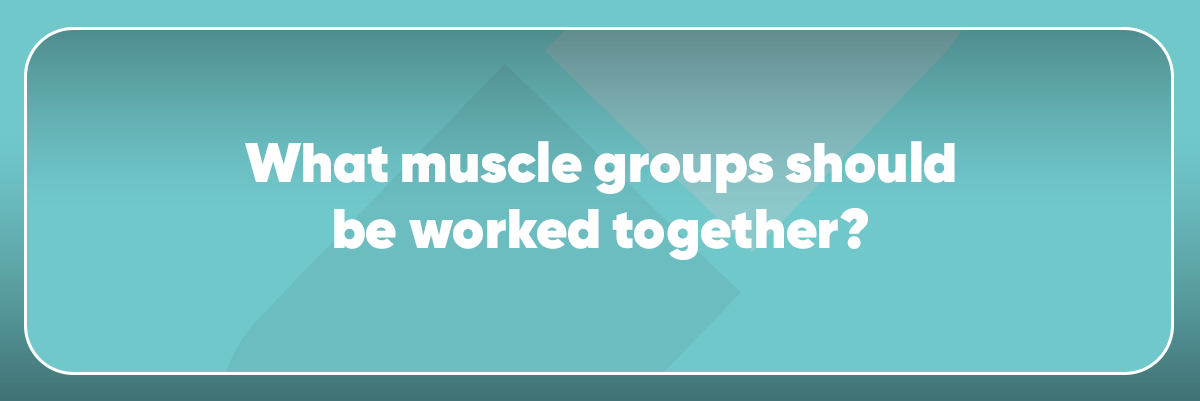Whether you’re thinking about joining a gym, starting to weight train, or have just hit a bit of a plateau with your workouts, this guide will give you an insight into what muscles you should be working together and what the key compound movements are, as well as some helpful advice on what supplements will complement your workout.
Working complimentary muscle groups as a unit is a great way to maximise the benefits of your workout because they activate more muscle fibres which in turn, results in more strength and more muscle (1). Your body will thank you for this as strengthening your muscles boosts your metabolic rate, which means you'll burn more calories even when your body is at rest (2).
What are the major muscle groups?
The body consists of more than 600 muscles, which account for about 40 percent of a person's weight (3). The primary muscle groups are divided into the six following areas:
- Chest
- Back
- Abs
- Arms
- Shoulders
- Legs
Within these significant groupings, there are also minor groupings. Multiple muscles make up each main muscle area:
- Legs: calves, quads, and hamstrings
- Arms: forearms, biceps, and triceps
- Back: rhomboids, traps, and lats
All of these individual muscles work together, so there's no point working out just one muscle or even one group if you want a healthy and defined body. For that reason, it's important to work out different groupings on the same day.
Try hammering one major muscle group (chest, legs and back) per workout and supplement this by splitting the rest of your session into moves that target the smaller muscle groups (biceps, triceps, hamstrings, calves, abs and shoulders). The combination of exercises can be totally up to you! We recommend starting with your compound movements first, as these tend to be the most strenuous and will tire your muscles out faster than isolation exercises.
Compound exercises and how to incorporate them into your workout
Personal trainers will tell you to include at least one or two compound movements per gym session. What is a compound movement? Compound exercises are movements that work multiple muscle groups at the same time. For example, a squat is a compound exercise that works the quadriceps, glutes, and calves.
Compound exercises, or compound movements, differ from isolation exercises which only work a single muscle group at a time. A traditional bicep curl is an isolation exercise meant to strengthen the biceps on their own, without the help of other muscles.
There are three types of muscles in your body: cardiac, smooth, and skeletal. Cardiac muscles are the muscles that control your heart. Smooth muscles control involuntary functions like constricting your blood vessels. Skeletal muscles are the muscles that you target in the gym that help your body move.
The big 5 compound movements
The five basic exercises are:
- Bench press
- Deadlift
- Squats
- Shoulder press
- Pull-up
These exercises are generally known as the big 5 of strength training (4). They became known to a broad public in the mid 70’s thanks to Arnold Schwarzenegger, who trained according to the big 5 scheme at that time.
Which muscle groups should I be training on the same day?
The human body has 600 muscles, but they are divided into several major muscle groups that work together and should be targeted together in a workout. A popular muscle group split that I’m sure you have heard of before is separating your muscle groups into push days, pull days and leg days. What this means is, that each muscle group is trained on its own separate day.
- Push Day - Chest, shoulders and triceps
- Pull Day - Back, biceps and abs
- Leg Day - Hamstrings, quads and calves
These three workouts are then alternated over however many weekly training sessions you choose to do.
If you’re looking to burn the most calories in a strength training workout, deadlifts in particular, are a great way to add that extra burn. This compound movement requires more muscles to work together and therefore burns the most calories. For example, the deadlift exercise, which works your legs, also requires your back muscles and upper body strength.
What is the biggest muscle group in the body?
Believe it or not, the gluteus maximus, aka, your bum, is the biggest muscle in your body! One that tends to be overlooked. Because of how our muscles work, the glutes are designed to be the strongest muscles in the body, if they aren’t trained like the rest of our muscles, it can lead to imbalances like back pain. The major muscles in this group include the gluteus maximus, gluteus medius and gluteus minimus. Your back forms the second largest group of muscles… So, get deadlifting and don’t skip pull-ups (even if you need a band to help!).
How often should I be training the main muscle groups?
Ideally, to build muscle, you would want to be training four days per week, alternating the workouts over your four training sessions. It doesn’t matter which days you choose as long as you never do more than two days in a row and work the same muscles. You'll want to progress from performing one or two sets to three sets of resistance exercises targeting major muscle groups, performing eight to 12 repetitions for each set while maintaining good form. Your last two reps should be a serious struggle if you want to make significant progress in your strength training.
You can also break up your strength training with a mixture of cardio workouts such as HIIT (high-intensity interval training) or Tabata training (this is when you do eight(ish) rounds of 20 seconds of strenuous exercise followed by 10 seconds of rest).
Supplements for maximum gym performance
- Turkesterone - This product may help improve your strength, enabling you to perform at your best whilst decreasing fat and building muscle. A must-have for serious gym-goers! You can read our Complete Guide to Turkesterone for more information.
- PR3 Ultimate Pre-Workout - Whether you’re new to the gym or a serious gym veteran, taking a pre-workout before you hit the weights is going to give you the edge you need. It increases your energy, boosting your focus and helps you perform at your best no matter what your workout routine. If you’re looking for a non-stimulant pre-workout, why not try our non-caffeinated PR3 Ultimate Pre-Workout.
- Joint support supplements - We recommend taking these to avoid injury and prevent joints from becoming inflamed.
Key Takeaways
In summary, your main muscle areas are your legs, arms, and back. The mixture of isolation exercises you want to perform is up to you however, if you want a full-body workout, we recommend performing at least one to two compound exercises per gym session. Many people follow the push, pull, legs split, alternating these groups across four gym sessions per week. Remember to push yourself on the last one to two reps but equally, remember to rest! This will give your muscles time to repair.






Leave a comment
All comments are moderated before being published.
This site is protected by hCaptcha and the hCaptcha Privacy Policy and Terms of Service apply.